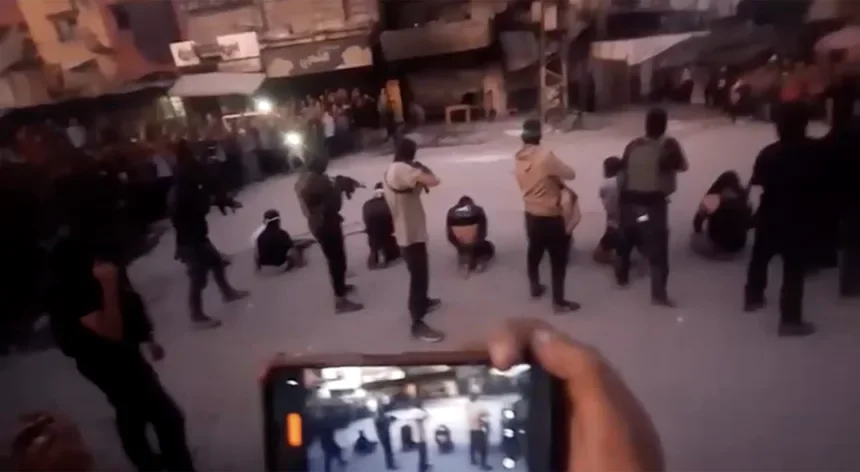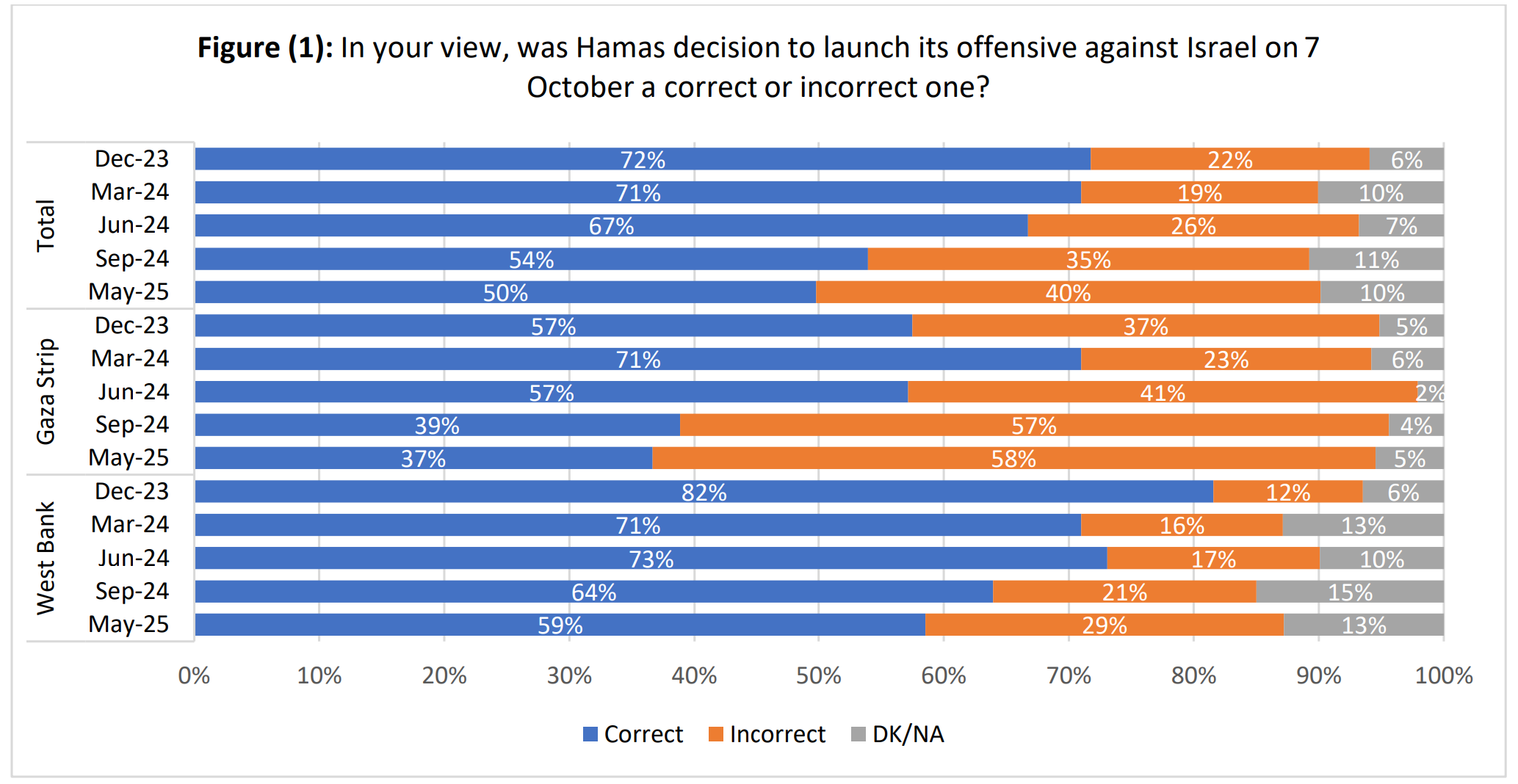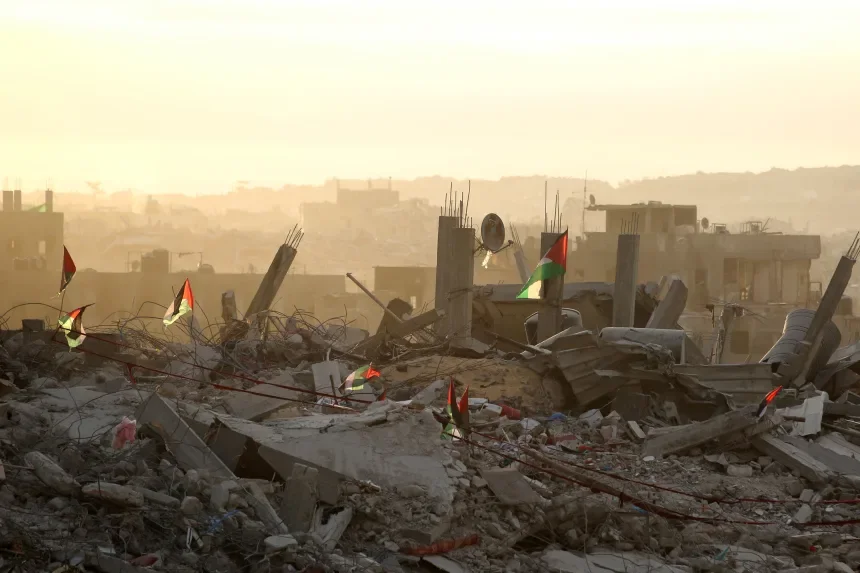Shock as Strategy: Why Hamas Executed Palestinians
Video shows Hamas armed men dragging seven men into a circle of people in Gaza City, forcing them to their knees and executing them. From Social Media/Reuters | CNN
Social media and mainstream outlets are circulating a gruesome execution video in which seven men were blindfolded and shot in front of a crowd of Palestinians. Reportedly, the executed men were collaborators. According to Reuters, Hamas is engaging with the Dugmush clan, and 30 people were executed, along with 60 arrested. Why is chaos breaking out in the Gaza strip following a peace deal? This article attempts to uncover the deeper motivations behind this gruesome video and how it plays a role within information warfare. These executions come amid a fragile peace process and raises questions about the current peace plan proposed by President Donald Trump.
“Information warfare is an operation conducted in order to gain an information advantage over the opponent. It consists in controlling one’s own information space, protecting access to one’s own information, while acquiring and using the opponent’s information, destroying their information systems and disrupting the information flow. Information warfare is not a new phenomenon, yet it contains innovative elements as the effect of technological development, which results in information being disseminated faster and on a larger scale.”
As listed in the Joint Publications 3-13, Information Operations (IO) is described as the integrated employment, during military operations, of IRC’s in concert with other lines of operation, to influence, disrupt, corrupt, or usurp the decision-making of adversaries and potential adversaries while protecting our own. The key part of this definition lies in affecting the decision-making of adversaries. It can be inferred that Hamas is attempting to influence the decision-making process of the international community and Israel, to collapse the recent negotiations.
President Donald Trump announcing a peace agreement between Israel and Hamas | Truth Social
President Donald Trump announced on Truth Social that both Israel and Hamas agreed to a proposed peace plan to bring an end to the war on Gaza. The current conflict has destroyed Gaza and left Israel in a difficult position, to balance its operations and maintain international relations. President Trump’s peace plan offered an alternative solution to all sides of the conflict, in which Hamas is able to operate, while unarmed and Israel is able to recover the last hostages taken in the October 7th attack. The peace plan lays the foundation for a possible two state solution between Israel and Palestine. Below is the 20 point peace planned outline by BBC.
Here is the full text of the president's plan, as provided by the White House:
1. Gaza will be a deradicalised terror-free zone that does not pose a threat to its neighbours.
2. Gaza will be redeveloped for the benefit of the people of Gaza, who have suffered more than enough.
3. If both sides agree to this proposal, the war will immediately end. Israeli forces will withdraw to the agreed upon line to prepare for a hostage release. During this time, all military operations, including aerial and artillery bombardment, will be suspended, and battle lines will remain frozen until conditions are met for the complete staged withdrawal.
4. Within 72 hours of Israel publicly accepting this agreement, all hostages, alive and deceased, will be returned.
5. Once all hostages are released, Israel will release 250 life sentence prisoners plus 1,700 Gazans who were detained after 7 October 2023, including all women and children detained in that context. For every Israeli hostage whose remains are released, Israel will release the remains of 15 deceased Gazans.
6. Once all hostages are returned, Hamas members who commit to peaceful co-existence and to decommission their weapons will be given amnesty. Members of Hamas who wish to leave Gaza will be provided safe passage to receiving countries.
7. Upon acceptance of this agreement, full aid will be immediately sent into the Gaza Strip. At a minimum, aid quantities will be consistent with what was included in the 19 January 2025 agreement regarding humanitarian aid, including rehabilitation of infrastructure (water, electricity, sewage), rehabilitation of hospitals and bakeries, and entry of necessary equipment to remove rubble and open roads.
8. Entry of distribution and aid in the Gaza Strip will proceed without interference from the two parties through the United Nations and its agencies, and the Red Crescent, in addition to other international institutions not associated in any manner with either party. Opening the Rafah crossing in both directions will be subject to the same mechanism implemented under 19 January 2025 agreement.
9. Gaza will be governed under the temporary transitional governance of a technocratic, apolitical Palestinian committee, responsible for delivering the day-to-day running of public services and municipalities for the people in Gaza. This committee will be made up of qualified Palestinians and international experts, with oversight and supervision by a new international transitional body, the "Board of Peace," which will be headed and chaired by President Donald J. Trump, with other members and heads of state to be announced, including Former Prime Minister Tony Blair. This body will set the framework and handle the funding for the redevelopment of Gaza until such time as the Palestinian Authority has completed its reform programme, as outlined in various proposals, including President Trump's peace plan in 2020 and the Saudi-French proposal, and can securely and effectively take back control of Gaza. This body will call on best international standards to create modern and efficient governance that serves the people of Gaza and is conducive to attracting investment.
10. A Trump economic development plan to rebuild and energise Gaza will be created by convening a panel of experts who have helped birth some of the thriving modern miracle cities in the Middle East. Many thoughtful investment proposals and exciting development ideas have been crafted by well-meaning international groups, and will be considered to synthesize the security and governance frameworks to attract and facilitate these investments that will create jobs, opportunity, and hope for future Gaza.
11. A special economic zone will be established with preferred tariff and access rates to be negotiated with participating countries.
12. No one will be forced to leave Gaza, and those who wish to leave will be free to do so and free to return. We will encourage people to stay and offer them the opportunity to build a better Gaza.
13. Hamas and other factions agree to not have any role in the governance of Gaza, directly, indirectly, or in any form. All military, terror, and offensive infrastructure, including tunnels and weapon production facilities, will be destroyed and not rebuilt. There will be a process of demilitarisation of Gaza under the supervision of independent monitors, which will include placing weapons permanently beyond use through an agreed process of decommissioning, and supported by an internationally funded buy back and reintegration programme all verified by the independent monitors. New Gaza will be fully committed to building a prosperous economy and to peaceful coexistence with their neighbours.
14. A guarantee will be provided by regional partners to ensure that Hamas, and the factions, comply with their obligations and that New Gaza poses no threat to its neighbours or its people.
15. The United States will work with Arab and international partners to develop a temporary International Stabilisation Force (ISF) to immediately deploy in Gaza. The ISF will train and provide support to vetted Palestinian police forces in Gaza, and will consult with Jordan and Egypt who have extensive experience in this field. This force will be the long-term internal security solution. The ISF will work with Israel and Egypt to help secure border areas, along with newly trained Palestinian police forces. It is critical to prevent munitions from entering Gaza and to facilitate the rapid and secure flow of goods to rebuild and revitalize Gaza. A deconfliction mechanism will be agreed upon by the parties.
16. Israel will not occupy or annex Gaza. As the ISF establishes control and stability, the Israel Defense Forces (IDF) will withdraw based on standards, milestones, and timeframes linked to demilitarization that will be agreed upon between the IDF, ISF, the guarantors, and the United States, with the objective of a secure Gaza that no longer poses a threat to Israel, Egypt, or its citizens. Practically, the IDF will progressively hand over the Gaza territory it occupies to the ISF according to an agreement they will make with the transitional authority until they are withdrawn completely from Gaza, save for a security perimeter presence that will remain until Gaza is properly secure from any resurgent terror threat.
17. In the event Hamas delays or rejects this proposal, the above, including the scaled-up aid operation, will proceed in the terror-free areas handed over from the IDF to the ISF.
18. An interfaith dialogue process will be established based on the values of tolerance and peaceful co-existence to try and change mindsets and narratives of Palestinians and Israelis by emphasizing the benefits that can be derived from peace.
19. While Gaza re-development advances and when the PA reform programme is faithfully carried out, the conditions may finally be in place for a credible pathway to Palestinian self-determination and statehood, which we recognise as the aspiration of the Palestinian people.
20. The United States will establish a dialogue between Israel and the Palestinians to agree on a political horizon for peaceful and prosperous co-existence.
While President Trump’s peace plan offered Hamas a potential off-ramp from isolation, the proposal also represented an existential threat to its authority. Accepting a deal that removes weapons, demilitarizes Gaza, and replaces Hamas governance with a transitional international committee would effectively dismantle the organization’s identity and control. For Hamas, survival depends on projecting dominance — not compromise. The executions in Gaza, therefore, can be seen as a calculated act of defiance, intended to communicate that Hamas still governs by fear, not negotiation.
Points 13, 16 and 17 offer direct and clear instructions to both Hamas and Israel. In Point 13, any infrastructure designed to continue Hamas’ campaign against Israel must be torn down. It also refers to a “New Gaza” suggesting that the old ways of governance from Hamas must change completely, if this peace deal is to work successfully. Point 16 is directed towards Israel, that it must leave Gaza gradually with the intent of offering it complete independence. Point 17, directed towards Hamas, explains what will happen if Hamas chooses to violate this peace deal.
Hamas released a 16-page document on the events of October 7. (Image: Palestine Chronicle)
Following the surprise attack of October 7th, Hamas released a 16-page document titled “Our Narrative…. Operation Al-Aqsa Flood.” This document outlines Hamas’ motivations for it’s attack and it’s operational goals. The fifth and last chapter is titled “What is Needed,” and there are multiple goals that Hamas wants, but #6 stands out the most.
Hamas does not want any interference from the international community in governing Gaza. Throughout this document, it refers to Israel’s war on Gaza as part of a larger “occupation.” In addition, Hamas seeks recognition of its struggle as justified resistance against Israel. Analyzing this document reveals that Hamas wishes to remain independent and pursue its own goals and recognition, while being recognized by the international community as a legitimate government.
This document addresses numerous false allegations that were broadcast and proved to be false, and stated that Hamas only targeted legitimate military officials. Any civilian casualties that resulted in October 7th, according to this document, were at the fault of the Israeli Defense Force. Two years after this document was published, the war continued with casualties mounting to staggering numbers.
Israel: Hamas War: Casualties including killed, injured, or displaced. Muhmad Hams/AFP via Getty Images; Gaza Min. of Health; WHO; Israel Min. of Foreign Affairs/Health/Defense; UN Office Coord. of Humanitarian Affairs | ABC News
The Israel-Hamas war has completely left Gaza in ruins, to which President Trump laid out specific times in his peace plan, that one of the main focuses was to rebuild Gaza. While Hamas initially seemed to reject any foreign interference, the casualty rate and deteriorating situation in Gaza seemed to force Hamas leaders to reconsider possible solutions to the current war. While civilian casualties mounted because of the fighting, Palestinians in Gaza began to turn on Hamas. According to the Palestinian Center for Policy and Survey Research, the support for Hamas decline rapidly. Palestinians were asked if the October 7th offensive was a correct decision, while it initially jumped to an all-time high in March 2024 with 71% as of May 2025 it rapidly declined to 37%. On December 2023, over 85% of Palestinians were satisfied of Hamas’ performance in the war, and now the number has declined to a rapid 43%. Discontent amoung Gazans and a rapidly declining approval rate, is leaving Hamas at a significant disadvantage. Hamas does not have any support and is completely geographically isolated from any nearby allies.
Graph presented by Palestinian Center for Policy and Survey Research
Earlier this year, in March 2025, a wave of anti Hamas protests broke out in the strip. Gazans demanded Hamas leave the strip and an end to the war. Hamas’ ambition and plans to attack Israel and ruin their legitimacy in the international community came at the cost of civilian infrastructure. As the war progressed and the humanitarian crisis deteriorated, the situation revealed Hamas’ inability to provide stability to the region. While Gazans may not have a favorable view of Israel, their disdain for Hamas comes from exhaustion, in a never ending war. While the history of Israel-Palestinan relations is a long and complicated view, the current view on the ground is that Gazans want a complete end to the war and see Hamas as an obstacle to ending it.
Palestinian flags flutter on top of rubble in Gaza City. Bashar Taleb/AFP/Getty Images | CNN
Hamas control over Gaza began to show signs of weakness, when looters were shot dead on sight, as reported by CNN. Hamas’ ability to govern the strip is completely weakened due to Israeli military operations and also internal strife. Most groups inside Gaza began to challenge Hamas’ claim over the region, with one group known as the Popular Forces. This group publically challenged Hamas and one of its commanders, advocating themselves as a better alternative to Gazans and the international community.
“To all the Hamas rats, your tunnels are destroyed, your rights no longer exist. Repent before it’s too late – there is no Hamas from today onward.”
Analysis
The recent executions serve to act as shock value to Gazans and the rest of the international community. Through public executions of “collaborators,” Hamas is attempting to hold on to its legitmacy as the rightful rulers of Gaza. However, public displays of brutality always tend to backfire and instead of installing fear and submission to the general population, it usually units them against a common enemy. Shock value videos are commonly used by unconventional groups to display strength to its audience. Shock value is temporary, but its effects on legitmacy is permanent. Hamas embracing public executions is evidence that it is struggling to hold on to Gaza.
These executions serve to shape perceptions, halt any uprisings and manipulate the flow of information. In addition to using these shock value videos to control Palestinians, these videos can also severly impact decision making of Western leaders. If violence broke out following the peace agreement, it would serve as a potential blow and weaken the international agreement laid out in President Trump’s peace plan, because it did not account for a complete collapse of the Gaza Strip.







